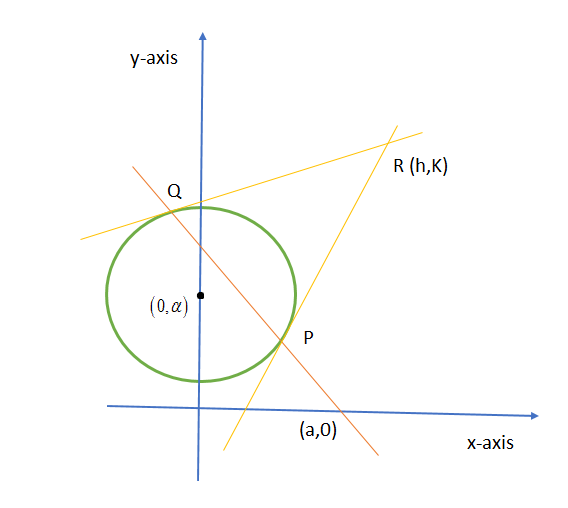Question
Question: A circle with radius \[\left| a \right|\] and centre on y-axis slides along it and a variable line t...
A circle with radius ∣a∣ and centre on y-axis slides along it and a variable line though (a,0) cuts the circle at points P and Q. The region in which the point of intersection of tangents to the circle at points P and Q lies is represented by
A. y2⩾4(ax−a2)
B. y2⩽4(ax−a2)
C. y⩾4(ax−a2)
D. y⩽4(ax−a2)
Solution
Hint: First of all, consider the centre of the circle as a variable on the y-axis and find the equation of the circle. Then find the equation of chord of contact at points P and Q. As the value of the y-coordinate of the centre of the circle is real, equate the value of discriminant to greater than or equal to zero.
Complete step-by-step answer:
Given radius of the circle is ∣a∣
Let (0,α) be the centre of the circle as the centre lies on the y-axis.
We know that the equation of the circle with centre (h,k) and radius r is given by (x−h)2+(y−k)2=r2.
So, the given circle equation is given by
Let R(h,k) be the point of intersection of the tangents to the circle at points P and Q as shown in the below figure:

We know that the equation of chord of contact at (x1,y1) to the circle x2+y2+2gx+2fy+c=0 is given by xx1+yy1+g(x+x1)+f(y+y1)+c=0.
So, the equation of chord of contact i.e., equation of PQ is given by
But this equation is passing through (a,0). So, this point should satisfy the equation PQ.
ah+(0)k−α(0+k)+(α2−a2)=0 ah−αk+α2−a2=0 α2−αk+ah−a2=0We know that for the equation ax2+bx+c=0 if x is a real value then its discriminant must be greater than or equal to zero i.e., b2−4ac⩾0.
In the equation α2−αk+ah−a2=0 as α is a real since it is a variable and lies on y-axis its discriminant must be greater than equal to zero.
So, we have
As we have to find the coordinates of (h,k), we substitute h=x and k=y, then we get
y2⩾4(ax−a2)
Thus, the correct option is A. y2⩾4(ax−a2)
Note: The chord joining the points of contact of the two tangents to a conic drawn from a given point, outside it, is called the chord of contact. For the equation ax2+bx+c=0 if x is a real value then its discriminant must be greater than or equal to zero i.e., b2−4ac⩾0.
